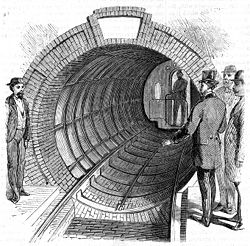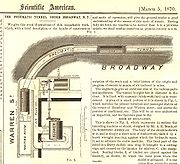
Beach Pneumatic Transit
Encyclopedia

New York City
New York is the most populous city in the United States and the center of the New York Metropolitan Area, one of the most populous metropolitan areas in the world. New York exerts a significant impact upon global commerce, finance, media, art, fashion, research, technology, education, and...
, USA.
History

Alfred Ely Beach
Alfred Ely Beach was an American inventor, publisher and patent lawyer, born in Springfield, Massachusetts.-Early years:Beach was born in Springfield, Massachusetts and was the son of a prominent publisher, Moses Beach...
and his Beach Pneumatic Transit Company of New York began constructing a pneumatic subway line beneath Broadway
Broadway (New York City)
Broadway is a prominent avenue in New York City, United States, which runs through the full length of the borough of Manhattan and continues northward through the Bronx borough before terminating in Westchester County, New York. It is the oldest north–south main thoroughfare in the city, dating to...
. (Beach had earlier demonstrated the basic system at the American Institute
American Institute
The American Institute of the City of New York was an organization to promote, by means of exhibitions and fairs, the interests of agriculture, commerce, manufactures, and arts in New York State and the United States.-History:...
Exhibition in 1867.) Funneled through a company he set up, Beach put up $350,000 of his own money to bankroll the project. Built in only 58 days, its single tunnel, 312 feet (95.1 m) long, 8 feet (2.4 m) in diameter, was completed in 1870 and ran under Broadway from Warren Street to Murray Street. With no initial political support for his project, he started the project claiming he was building postal tubes
Pneumatic tube
Pneumatic tubes are systems in which cylindrical containers are propelled through a network of tubes by compressed air or by partial vacuum...
. The initial permit was to install a pair of smaller postal tubes below Broadway but was later amended to allow the excavation of a single large tunnel wherein the smaller tubes could reside. The exact location of the tubes was determined during construction by compass and survey as well as verified by driving jointed rods of iron up through the roof of the tunnel to the pavement. The line was built as a demonstration of a pneumatic transit system, open to the public with fares donated to charity. Proceeds of the 25 cent admission went to the Union Home and School for Soldiers' and Sailors' Orphans.
It remained little more than a curiosity, running only a single car on its one-block-long track to a dead-end at its terminus. (Passengers would simply ride out and back, to see what the proposed subway might be like.) During its first two weeks of operation, the Beach Pneumatic Transit sold over 11,000 rides with 400,000 rides provided during its first year of operation. It was designed as a very ornate project. The station was adorned with frescoes and easy chairs. Zircon
Zircon
Zircon is a mineral belonging to the group of nesosilicates. Its chemical name is zirconium silicate and its corresponding chemical formula is ZrSiO4. A common empirical formula showing some of the range of substitution in zircon is 1–x4x–y...
lamps revealed the luxurious interior of the station. There were statues and a gold fish pond in the station that people could look at while they waited for their turn to enter the ride. The car could hold 22 people and the riders would enter the site at Devlin's Clothing Store, a well known shop, located at 260 Broadway, on the southwest corner of Warren Street. The ride was controlled by a 48-ton fan, nicknamed "the Western Tornado", built by "Roots Patent Force Rotary Blowers". When the car reached the end, the baffles on the fan were reversed and the car was pulled back by the suction. Although the public showed initial approval, Beach was delayed in getting permission to expand it due to official obstruction for various reasons (see Alfred Beach article). By the time he finally gained permission in 1873, public and financial support had waned, and the subway was closed down. The final blow to the project was a stock market crash
Panic of 1873
The Panic of 1873 triggered a severe international economic depression in both Europe and the United States that lasted until 1879, and even longer in some countries. The depression was known as the Great Depression until the 1930s, but is now known as the Long Depression...
which caused investors to withdraw support. It is unclear that such a system could have been practical for a large-scale subway network.
After the project was shut down, the tunnel entrance was sealed and the station, built in part of the basement of the Rogers Peet Building
Rogers Peet Building
Rogers Peet Building was a five-story structure which was built in Manhattan in 1863. It was home to the Rogers Peet clothing store until December 4, 1898. It belonged to the Emanuel Hoffman estate and was one of the historic buildings of New York City...
, was reclaimed for other uses. The entire building was lost to fire in 1898. In 1912, workers excavating for the present-day BMT Broadway Line
BMT Broadway Line
The BMT Broadway Line is a rapid transit line of the B Division of the New York City Subway in Manhattan, New York City, United States. , it is served by three services, all colored yellow: the on the express tracks and the on the local tracks...
dug into the old Beach tunnel, where they found the remains of the car and the tunnelling shield
Tunnelling shield
A tunnelling shield is a protective structure used in the excavation of tunnels through soil that is too soft or fluid to remain stable during the time it takes to line the tunnel with a support structure of concrete, cast iron or steel...
used during initial construction. The shield was removed and donated to Cornell University
Cornell University
Cornell University is an Ivy League university located in Ithaca, New York, United States. It is a private land-grant university, receiving annual funding from the State of New York for certain educational missions...
, which has since lost track of its whereabouts. No part of this line remains as the tunnel was completely within the limits of the present day City Hall Station
City Hall (BMT Broadway Line)
City Hall is a local station on the BMT Broadway Line of the New York City Subway. It is served by the R train at all times except late nights and by the N train during late night hours...
under Broadway. The New York Historical Society commissioned a plaque honoring Alfred E Beach to be placed in the City Hall station.
A very similar but longer pneumatic system
Crystal Palace pneumatic railway
The Crystal Palace pneumatic railway was an experimental atmospheric railway constructed near Crystal Palace Park in South London c.1864.-History:...
operated in 1864 on the grounds of The Crystal Palace
The Crystal Palace
The Crystal Palace was a cast-iron and glass building originally erected in Hyde Park, London, England, to house the Great Exhibition of 1851. More than 14,000 exhibitors from around the world gathered in the Palace's of exhibition space to display examples of the latest technology developed in...
in London
London
London is the capital city of :England and the :United Kingdom, the largest metropolitan area in the United Kingdom, and the largest urban zone in the European Union by most measures. Located on the River Thames, London has been a major settlement for two millennia, its history going back to its...
.
In popular culture
The Beach Pneumatic Transit has achieved the status of an urban legendUrban legend
An urban legend, urban myth, urban tale, or contemporary legend, is a form of modern folklore consisting of stories that may or may not have been believed by their tellers to be true...
in New York subway lore.
In the 1973 book The Taking of Pelham One Two Three, one of the robbers wonders if he will wind up in the missing subway tunnel.
In the 1989 movie Ghostbusters II
Ghostbusters II
Ghostbusters II is a 1989 science fiction comedy film produced and directed by Ivan Reitman. It is the sequel to the 1984 film Ghostbusters and follows the further adventures of a group of parapsychologists and their organization which combats paranormal activities...
, it is referred to as the New York Pneumatic Railroad (NYPRR). The film depicts the fictional Van Horne Station beneath the intersection of East 77th Street and First Avenue, where a subterranean river of ectoplasm flows through its tunnels toward the fictional Manhattan Museum of Art. It is interesting to note that the building used for filming the Manhattan Museum of Art's exterior was actually the Alexander Hamilton U.S. Custom House
Alexander Hamilton U.S. Custom House
The Alexander Hamilton U.S. Custom House is a building in New York City, built 1902–1907 by the federal government to house the duty collection operations for the port of New York. It is located near the southern tip of Manhattan, next to Battery Park, at 1 Bowling Green...
near Battery Park
Battery Park
Battery Park is a 25-acre public park located at the Battery, the southern tip of Manhattan Island in New York City, facing New York Harbor. The Battery is named for artillery batteries that were positioned there in the city's early years in order to protect the settlement behind them...
, which is within a mile of the original Beach Pneumatic Transit's tunnel location.
Neal Schusterman's Young Adult Novel Downsiders
Downsiders
Downsiders is an award-winning 1999 novel by Neal Shusterman.-Plot summary:The Downsiders which is located underneath New York City, is a secret community of over 5,000 people that are never allowed to travel to the Topside...
makes many references to the Beach Pneumatic Transit.
The novel Faces in the Crowd by William Marshall
William Leonard Marshall
William Marshall is an Australian author, best known for his Hong Kong-based "Yellowthread Street" mystery novels, some of which were used as the basis for a British TV series....
depicts the abandoned station and tunnel as the headquarters of a criminal plot.
The song "Sub-Rosa Subway" on the first album by the Canadian rock band Klaatu, titled: 3:47 EST
3:47 EST
The album ends with a mouse squeak.-Origin of the title:In the 1951 science fiction film The Day the Earth Stood Still, the alien emissary Klaatu arrives in Washington, D.C. at 3:47 in the afternoon Eastern Standard Time...
, is about Beach's subway.
The image shown at the top of this page, along with other relevant material such as contemporary local newspaper headlines about the subject, is featured on the New York subway-themed murals of many Subway Restaurants.
The film An American Tail: The Treasure of Manhattan Island
An American Tail: The Treasure of Manhattan Island
An American Tail: The Treasure of Manhattan Island, titled in the film as An American Tail III: The Treasure of Manhattan Island was the first direct-to-video and third film in the An American Tail series. This film was first released in the UK in 1998. It was released by Universal Studios Home...
involves the main characters Fievel Mouskewitz and Tony Toponi exploring a series of caverns directly beneath one of the abandoned terminals for the Pneumatic Transit system.
External links
- Article by Joseph Brennan
- www.nycsubway.org
- New York's Secret Subway
- PBS documentary about the subway in the American Experience strand entitled The Secret Subway.
- "Pneumatic Transit" Animation by Abby Digital

